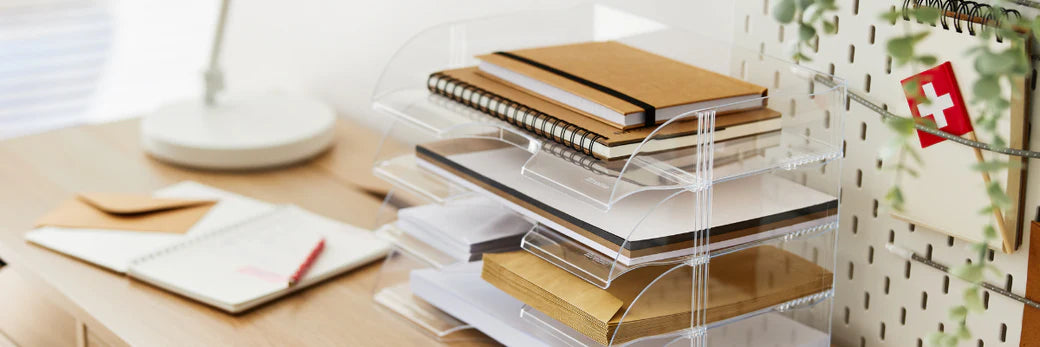Document sorting at home and in the office

Or stay in our Polish store
Or stay in our Polish store
Or stay in our Polish store
Or stay in our Polish store
In today's world, where we handle many matters online, we still have to deal with papers and documents. Due to their number, organizing documents at home and in the office can be cumbersome. The lack of an effective paper storage system can lead to chaos and wasted time. In this article, we will present proven methods and tips that will help you take control of the paper mess and create an effective system for organizing documents at home that will help maintain order.
Document organization at home should be primarily ordered and logical to allow for easy and quick retrieval of necessary documents when needed. It is worth starting by dividing documents into categories, e.g., financial documents, business documents, medical, insurance, tax, etc. Within each of these categories, further subdivision into subcategories can be made, e.g., electricity, gas, water, internet bills in the financial documents category.
Document organization at home should be primarily ordered and logical to allow for easy and quick retrieval of necessary documents when needed. It is worth starting with dividing documents into categories, e.g., financial documents, business documents, medical, insurance, tax, etc. Within each of these categories, further subdivision into subcategories can be made, e.g., bills for electricity, gas, water, internet in the category of financial documents.
Next, each category should be placed in a separate binder or use document drawers, and inside, additional divisions can be applied using dividers or boxes, labeled with the names of individual subcategories. This will make it easier to find a specific document, as well as to add new documents to it without disrupting the order and organization.
It is also important to store essential and sensitive documents in a place that is easily accessible but at the same time secure, e.g. in a locked cabinet or in a safe. Additionally, it is worth ensuring that the place where we store documents is dry and free from moisture and protected from external factors such as sunlight or water.
The correct document organization strategy at home should include several steps.
It is necessary to carefully analyze the types of documents we have and determine which ones need to be kept and which can be destroyed. It is also worth considering which documents are personal and which are business-related.
Next, based on the results of the analysis, a document organization plan should be developed. At this step, it is important to establish which categories of documents will be distinguished and what their names will be. It is also worth considering how to arrange the documents. If we already have a cleaning plan, we can start sorting the documents.
In the second step, it is necessary to carry out the sorting of documents. All papers should be organized according to the established organizational plan. They can be placed in appropriately labeled folders, use a binder or other carriers. The most important categories to pay attention to include:
Maintaining order is a key step in the document organization strategy. It is worth regularly reviewing documents and removing those that are no longer needed. This way, we will keep order and avoid the accumulation of unnecessary papers.
Storing documents will be made easier with the right accessories. Folders, organizers, sleeves, document drawers, and even entire filing cabinets are just a few options for proper document storage. To make it easier to find the necessary papers later, it is worth using sticky notes.
It is important to remember that cardboard boxes will not protect our papers. It is better to opt for plastic storage boxes. They will protect the contents not only from moisture but also from mice and moths. Sugar ants also pose a threat to our contracts and employment certificates, as they have the ability to digest cellulose.
In summary, a proper strategy for organizing documents at home should be based on analysis and planning, organizing documents according to an established plan, and maintaining order through regular reviews and the removal of unnecessary documents.
ZUS RMUA or PIT forms are the only confirmation of the fact that employers pay contributions for employee pensions. Since ZUS is unable to detect all errors that may occur in the settlement documentation, it is best to keep the mentioned documents for a rainy day.
In the case of individuals paying contributions independently, the contributor should keep copies of settlement declarations and monthly personal reports, as well as documents correcting them for a period of 5 years. The period begins from the day they are submitted to ZUS in electronic or paper form.
In addition to settlements, the contributor should also collect bank documents confirming the payment of contributions. Unfortunately, the Social Insurance System Act does not specify the period for which they should be kept.
The storage time for warranty cards, receipts, and proof of purchase depends on several factors, such as the type of product, warranty period, tax regulations, and individual needs and preferences. However, it is generally recommended to keep these documents for a period of several months to several years.
It is worth remembering that as customers, we have the right to challenge purchased products not only in cases where they are not in accordance with the contract but also in situations such as incorrect pricing, issuing incorrect change, or selling expired food products. Receipts confirming the purchase of food items should be kept for a short time - usually about three days from the date of purchase, in the case of reporting product defects. Similarly, when it comes to purchasing fruits and vegetables sold by weight - we have only three days to file a complaint.
In the case of purchasing footwear, clothing, furniture, cars, or RTV equipment, it is worth keeping receipts for a period of two years. Why? Because during this time we have the right to make a complaint in case a defect in the product is detected. The same right applies to purchases discounted during sales. However, it should be remembered that in the case of purchasing used goods, the complaint period usually lasts a minimum of one year. Therefore, it is worth keeping receipts and documents confirming purchases in order to be able to exercise our rights as consumers.
It is also worth remembering that keeping too many documents can lead to unnecessary clutter and take up valuable space, so it is advisable to regularly review your papers and get rid of those you no longer need.


